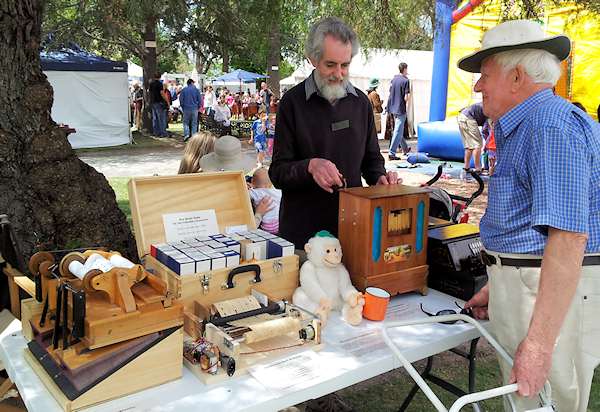 Small organs and organettes.
Small organs and organettes.
The whole purpose of mechanical musical instruments is to make music, whether at home, in commercial premises, or out and about in public places.
The person who plays a mechanical instrument in public is traditionally known as an "organ grinder". Organ grinders were a very common sight in cities and towns from the 1800s to the 1920s. They played an important part in bringing music to the general public in the days before gramophones, radio, and modern electronic devices.
Here are a few photos of some of my crank organs and organettes in action at various rallys, festivals, and local community events.
 Small organs and organettes.
Small organs and organettes.
This display of small organs and organettes attracted considerable interest at the Horsham Garden Festival in 2011. The items demonstrated included (left to right) a Celestina organette (without its case, in order to show the workings), a home-made electronic roll scanner with a case of home-made rolls, a home-built 14-note pipe organ, and a Gem roller organ.
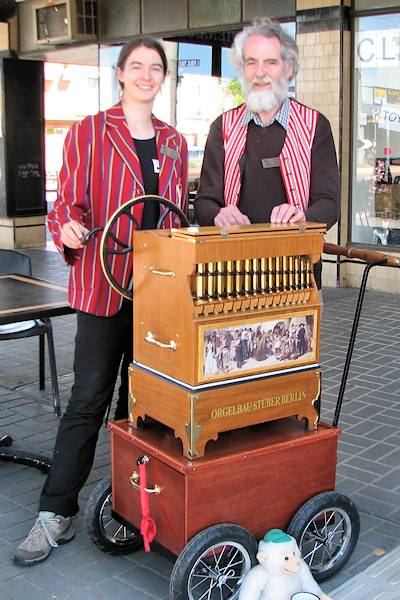 The Stüber crank organ.
The Stüber crank organ.
My usual "busking" instrument is a 26-note "Violinpan" organ built by Axel Stüber in Berlin in 1988. The name comes from the melody section, which has 15 brass piccolo (or "Pan") pipes and 15 selectable violin pipes. The 26-note "German" or "Deleika" scale provides more musical possibilities than the usual 20-note busker organs, while keeping the instrument relatively compact and much easier to transport than the larger 31-note models. The home-made organ cart has storage for 20 music rolls which play for 10-15 minutes each, providing sufficient music to play for over 4 hours without repeating. Most of the rolls are home-made from my own arrangements or adaptations. The lovely lady is my daughter Anna, who also (sometimes) plays piano and trumpet.
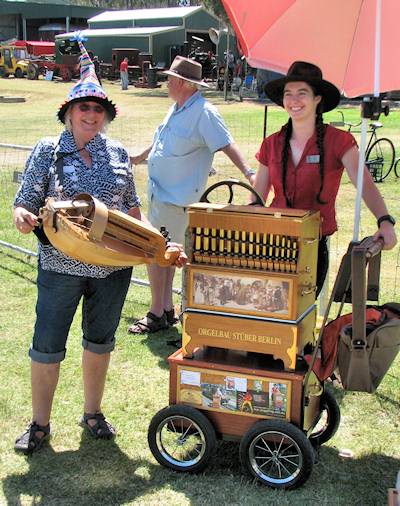 The Stüber organ with hurdy-gurdy.
The Stüber organ with hurdy-gurdy.
Anna with the Stüber organ at the Campbelltown Steam and Machinery Museum (Sydney, NSW), accompanied by friend Pam with her home-built hurdy-gurdy.
The name "hurdy-gurdy" is often applied (incorrectly) to any sort of mechanical contrivance or musical machine, but it actually refers to a specific type of hand-played stringed instrument. There is more about the hurdy-gurdy in Wikipedia.
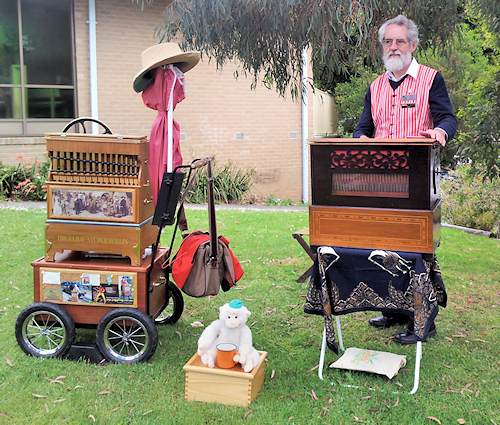 The Chiappa barrel reed organ.
The Chiappa barrel reed organ.
Here we are setting up to play at the Ferntree Gully village festival with a hundred-year-old barrel reed organ by Chiappa of London. The organ has 31 keys and 2 interchangeable barrels with 8 tunes on each. The selection of patriotic tunes suggests that the organ (or at least, the barrel) was made around the time of the first world war.
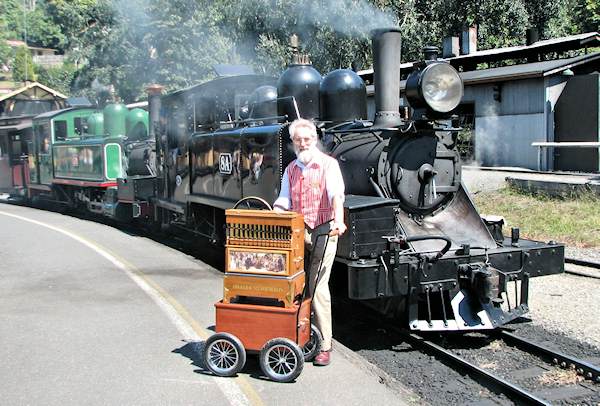 At Puffing Billy Railway.
At Puffing Billy Railway.
The Stüber organ plays "old-time" music most weekends (weather permitting) at the hundred-year-old Puffing Billy Railway in the Dandenong Ranges, about 40km from Melbourne. Visitors are always welcome.
Donations collected by the mechanical monkey (see photo above) go towards the preservation and maintenance of the historic locomotives.
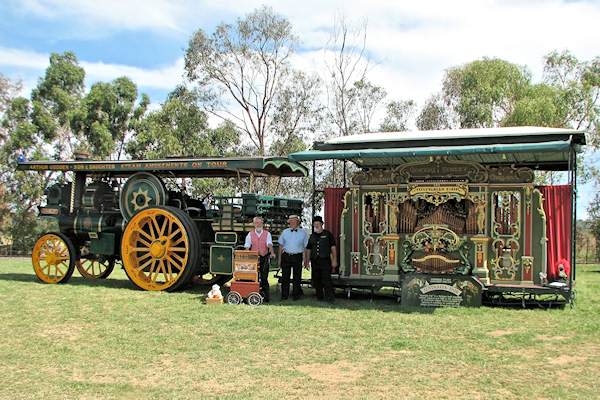 "Mine is bigger than yours...".
"Mine is bigger than yours...".
The little Stüber organ had some serious competition at the annual Scoresby steam rally in 2013 when Rick Alabaster (centre) arrived with his "Australia Fair" travelling concert organ. Australia Fair is a grand 73-key organ custom-built by John Verbeek of Belgium. It has travelled the length and breadth of Australia several times over the past 20 years or so. On this occasion it was towed by Arthur Godden (right) and his fully-restored showman's steam engine.
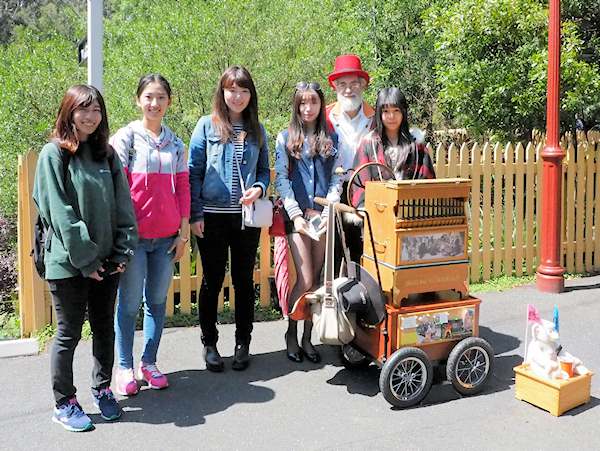 It's not all hard work...
It's not all hard work...
Playing the barrel organ outdoors brings many joys - sunshine and fresh air, old-time happy music, children dancing, and the opportunity to meet and talk with interesting people from all over the world. And, of course, the lovely ladies (and a good few gentlemen) who want their photo taken with the organ grinder!
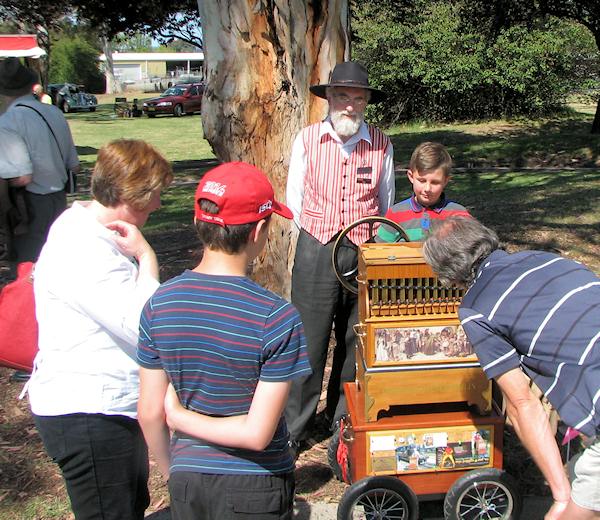 Engaging the next generation...
Engaging the next generation...
To ensure the long-term preservation of our mechanical instruments, it is essential that we re-kindle an awareness and appreciation among the general public - and especially the younger generation.
Many elderly passers-by remember organ grinders from their childhood, but children today have never seen recorded music that doesn't need a computer. Some are fascinated that music can come from just wood and paper, and drag their whole families over to look.
Whenever possible I will stop and explain the workings to those who take a serious interest. They are given a small leaflet describing the instrument and its music, and are sometimes invited to try their hand at playing.
This young lad did an excellent job during a family visit to the Bathurst Miniature Railway in 2014. Hopefully he will remember the experience and tell his school friends about it, and perhaps one day we might see a new organ-grinder to continue the tradition.